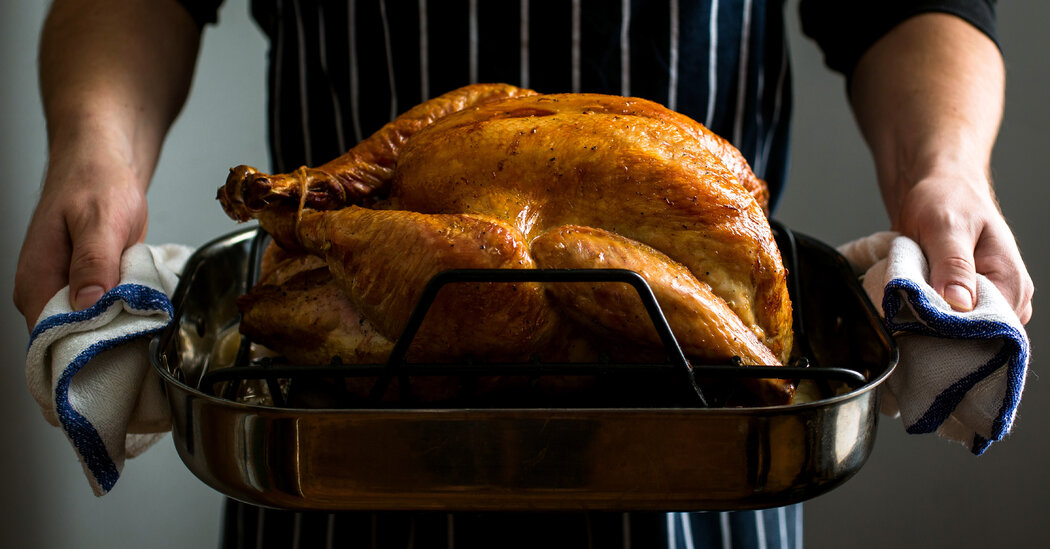
Making a Thanksgiving turkey is much easier than you think. Really! But whether it’s your first time making the bird, or your 50th, questions are bound to come up. New York Times Cooking has anticipated some of your most frequently asked questions, many of which we get year after year. Below, you’ll find the answers, and hopefully some peace of mind. Just remember: Whatever happens, it’ll all be great. Promise. (Still planning the feast? New York Times Cooking has many recipes to fill your table.)
What temperature is my turkey done?
The turkey is done when the internal temperature reads 165 degrees at the thickest part of the thigh.
That said, it’s OK to pull your bird out if it’s just a bit under 165 degrees, the United States Department of Agriculture’s standard.
If you’re making just the breast, like Eric Kim’s salt-and-pepper turkey breast and Mark Bittman’s roast turkey breast, it’s even wise to pull it out a few degrees shy of 165, as breast meat has a tendency to lose its moisture at higher temperatures.
In all cases, the turkey will continue cooking as it rests, and it’s better to pull the turkey out ever-so-slightly early than risk tough, overcooked meat.
Lastly, if you stuff your bird, you’ll want to measure its temperature as well. It should be 165 degrees on an instant-read thermometer.
Recipe: Simple Roast Turkey | Fastest Roast Turkey | Salt-and-Pepper Turkey Breast | Roast Turkey Breast | Buttermilk-Brined Turkey Breast
Where should I check the temperature on a turkey?
Insert your instant-read thermometer into the thickest part of the thigh and under the wing, as Melissa Clark recommends. The U.S.D.A. also suggests inserting your thermometer in “the thickest part of the breast, the innermost part of the thigh and the innermost part of the wing.” But avoid touching the bones, which can alter the temperature reading.
For Thanksgiving, it’s really worth investing in an instant-read thermometer. (The Wirecutter’s top pick comes in at $21 and will find many uses beyond the holiday.) But, if you don’t have a thermometer, you can use a fork to pierce the thickest part of the thigh. If the juices run clear, it should be done. A little pinkness in the thigh meat is not a bad sign, but if something looks translucent and pink, with pink or red juices (especially in the breast), it’s not ready.
Remember that if you pull out the bird too early, Thanksgiving isn’t ruined. Worst case scenario, you can serve the parts that are done, while you put the rest back into a hot oven to keep cooking.
Should you cover a turkey with foil?
The shape of turkeys doesn’t lend itself well to even cooking, especially if you’re not spatchcocking the bird (see Samin Nosrat’s buttermilk-brined roast turkey and Kenji López-Alt’s mayo-roasted Thanksgiving turkey). Aluminum foil can help you get a more uniformly burnished bird. If you see the breast parts starting to brown too much, cover them loosely with foil to keep them from burning before the rest of the bird cooks. You can also cover your turkey once it’s out the oven and resting, but again a loose tent is key: A tight covering can create steam, which can, in turn, make that hard-earned crispy skin soft and soggy.
Recipes: Buttermilk-Brined Roast Turkey | Mayo-Roasted Thanksgiving Turkey
How long should the turkey rest before carving?
“The amount of resting time depends on the size of the bird, but at least 20 minutes is needed,” Julia Moskin wrote back in 2011. “A large bird can wait up to 40 minutes or longer, depending on the temperature of the room.” Aim for about 45 minutes and up to an hour for larger birds.
How often should I baste a turkey?
About every 45 minutes is a good estimate, though there’s no hard and fast rule.
Basting keeps the turkey’s meat — particularly the breast meat — from drying out. To do it, you can either take the juices from the pan and spread them over the top of the bird with a baster or a brush. If your bird hasn’t yielded enough pan juices, you can use melted butter, too.
Speaking of those pan juices, if you’re wondering how to make turkey gravy from drippings, this recipe can help. So can our How to Make Gravy guide.



